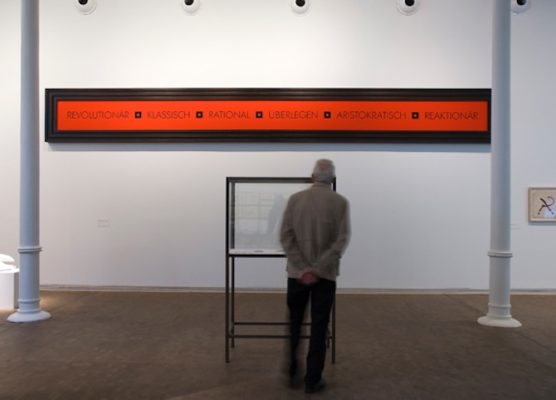Search
To search for an exact match, type the word or phrase you want in quotation marks.
A*DESK has been offering since 2002 contents about criticism and contemporary art. A*DESK has become consolidated thanks to all those who have believed in the project, all those who have followed us, debating, participating and collaborating. Many people have collaborated with A*DESK, and continue to do so. Their efforts, knowledge and belief in the project are what make it grow internationally. At A*DESK we have also generated work for over one hundred professionals in culture, from small collaborations with reviews and classes, to more prolonged and intense collaborations.
At A*DESK we believe in the need for free and universal access to culture and knowledge. We want to carry on being independent, remaining open to more ideas and opinions. If you believe in A*DESK, we need your backing to be able to continue. You can now participate in the project by supporting it. You can choose how much you want to contribute to the project.
You can decide how much you want to bring to the project.

“Contra Tàpies” at the Tàpies Foundation is presented as an ambitious critical re-writing of the artist; in other words the exhibition endeavours to update the figure of the artist and his work, adapting it to the languages of the most contemporary curators, making it an attractive discourse. It’s about dealing with the present, or rather non-present, of Tàpies. Even assuming the many risks, the operation in itself is framed within a curatorial tightrope-walk of our present, and any curator, if they want to come out smiling, needs to make sure the ropes are tied good and fast, and procedures are followed to the letter. This seems to be the greatest point of friction here; that is, making the intentions and the results coincide in such a way that the exhibition forms an organic whole that no longer needs to lean on a curatorial hypothesis that in this case flies way overhead.
It is frequent among today’s curators for the processes of re-renewing, re-discovery and re-writing of canonical figures to go through filters of displacement, de-consecration and proximity. A large number of these post-mortem exercises are not so much a settling of scores as the reclamation of unrecognised universalities. But “Contra Tàpies” is neither one thing nor the other. Nor is it a corrective de-idealisation of his figure as an artist. The problem in judging this exhibition lies in the multiplicity of pathways that it opens up, beyond the strict methodological programme and mapping self-imposed by curator Valentín Roma and the institution.
Looking at it carefully – in this sense it is an exhibition to lose oneself in, for which one is grateful – it would seem that Tàpies long hegemonic shadow over Catalan art (and by extension Spanish art) does not exist, or rather it’s not the time to show it. On the other hand, the exercising of liberation from the “anxiety of influence” in current generations that Harold Bloom spoke of is stressed. Only the presence of Pep Agut connects these equidistant points.
There is a whole series of possibilities and potentialities suspended in the air like “lines of force” that pulling in opposite directions or never really seem to be at full tilt: we don’t know if this is a restoration of Tàpies as a politically committed artist or whether he is incriminated as one who collaborated with the powers that be. The exhibition could have been a defence of Tàpies against his admirers, a much more effective way of combating his numerous detractors. But it isn’t exactly that either. Instead of “contra” the exhibition could very well have used the generic prefix “post”: that is, a sufficiently broad category to include a bit of everything (revision, renewal, creation of discourse and so on) in the first significant exhibition since his death.
David G. Torres ironically said in this same space that the inclusion of Tàpies in other group exhibitions “his inclusion was for merely formal reasons (paintings with stains with paintings with stains)”. Apparently in this case it is a question of turning this formalism around through “contentism” that scrutinizes a line of argument and then goes on to assign artists and works to it – some of them diametrically opposed.
It is as if there were not infinite other weighty arguments in the works selected to dissuade against this type of association of ideas. Some “hits” in the exhibition point to this renewed formalism of content: Rock My Religion by Dan Graham, the video by Bruce Nauman and, especially, Beuys singing on television to/against Ronald Reagan. Each of these seen in a monad of experience is delightful but, against Tàpies? The main problem with this exhibition lies in the homogenizing dominance of the concept – that abstract world which here has become a hypothesis more than a thesis – on the uniqueness of objects (the specific details). They rebel against the totalizing effect to which they are submitted and in doing so dismantle the concept itself.
The prize in this section goes to Saló o le 120 giornate di Sodoma by Pasolini. The puritanical and scatological in Tàpies’ work does not justify the lewd exhibition of this film, played in a continuous loop within an institutional art space. In my opinion, the thematic connection with Tàpies is surpassed by curatorial exhibitionism. If there is a film in the history of cinema that demands a self-imposed and self-critical restriction in its use it is precisely Saló. Otherwise its violence and torture are rendered banal by a click of the loop button presenting Saló as if it were video art and suitable for all audiences.
In my eyes this reduction to the banal contaminates the rest of the exhibition, which in itself could have been a great deal more rigorous without the presence of “hits” (although of course that would have made it less fun, less clever, less postmodern). It could also have been less experimental, in short, less “Contra Tàpies”. What is really interesting is the model of institutionalism that the exhibition proposes from now on; time will tell whether the ban has been lifted on other post-contemporary readings or if, conversely, this first attempt will be relegated to the ever-unfortunate category of ‘strangeness’, cancelling in passing any other future possibility or the opposite, as institutional criticism has done: broadening the limits of the institution.

Peio Aguirre writes about art, film, music, theory, architecture and politics, amongst other subjects. The genres he works in are the essay and meta-commentary, a hybrid space that fuses disciplines on a higher level of interpretation. He also (occasionally) curates and performs other tasks. He writes on the blog “Crítica y metacomentario” (Criticism and metacommentary).
"A desk is a dangerous place from which to watch the world" (John Le Carré)